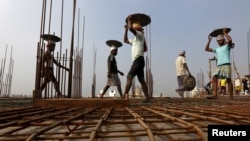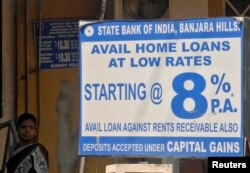When Rajnish Dhall's driver wanted to borrow money to buy a home, Dhall suggested he go to a bank. But without proof of income or tax returns to show his credentials, the driver said no bank would lend to him.
It was the start of a whole new business for Dhall, a former banker whose firm aims to help the hundreds of millions of informal workers who make up the bulk of India's labor force.
They are the newly emerging home-owning class.
"My driver was earning a steady income and could have paid back the loan easily, yet none of the banks would lend to him because he didn't have the necessary paperwork," Dhall told Reuters. "The housing problem is very real and visible, especially in a city like Mumbai. There is certainly aspiration to own a home, but without finance, there is no way to realize the aspiration."
Dhall lent his driver the money, then looked more closely at home loans for a host of other workers in the informal sector.
Of India's 470 million-strong workforce, about 90 percent is in the informal sector. They include domestic help, street vendors, daily wage earners and small business operators, who may have no collateral and whose incomes are irregular.
They have few options besides borrowing from money lenders and employers, Dhall found. So he set up Micro Housing Finance Corp. to give home loans to low-income and informal workers.
Housing for all
More homes are desperately needed.
Already, one in three Indians live in cities, many in crowded slums and other informal settlements. Every year, tens of thousands of villagers migrate to cities in search of jobs, and the pace of urbanization is set to rise.
India has a shortage of about 20 million urban homes; the shortfall disproportionately affects families earning less than 16,000 rupees ($248) a month, according to consultancy KPMG.
Prime Minister Narendra Modi has made affordable housing a priority, offering incentives such as subsidized loans to meet a 2022 target of "Housing for All," even as critics say the plan bypasses the homeless.
The government plan aims to create 20 million new urban homes and 30 million rural homes.
An affordable home is typically about 250 square feet (23 square meters) in size, and can cost up to 1.2 million rupees ($18,600). It is aimed at families earning 8,000-25,000 rupees a month, and is usually located in the outskirts of the city where land is cheaper.
In recent years, developers including the Tata group, Mahindra and TVS group have entered the affordable housing market, enticed by government incentives and future potential.
These big firms have enhanced the quality and reputation of affordable homes, which were once described as "vertical slums."
About 15 micro home finance companies have also launched, with reputable builders and more ready finance combining for better results for low-income earners.
Increasingly, it is a choice between "owning a good-quality, formal home in the periphery of the city over a badly made or informal home in the city," said Vikram Jain, director of social consultancy FSG, which has studied the segment.
"With more developers and better access to finance, they are well designed, quality constructions that residents take pride in owning," he told Reuters.
From chalk to pigeons
India's micro housing finance companies have a loan portfolio of more than $160 million, with near-zero defaults, Jain estimates.
But micro home loans of up to 1 million rupees for low-income clients only account for a quarter of home loans.
Micro home finance companies lend up to 90 percent of the value of the property, at slightly higher interest rates of about 13 percent, on average. The repayment term can be up to 25 years.
Since its founding, MHFC has dispensed about 14,000 home loans, Dhall said.
Its customers represent 600 diverse professions — from a man selling grains to feed pigeons, to one making marking chalk for tailors, and a grass seller for people with cows at home.
At Aadhar Housing Finance — owned in part by the World Bank's International Finance Corporation — more than three-quarters of customers did not have a credit history when they asked for a loan, said Chief Executive Deo Shankar Tripathi.
Aadhar has given more than 50,000 home loans, mostly in India's poorest states where customers typically buy a plot of land and build a modest home, Tripathi said.
The high cost of land needed to build homes can be a challenge to affordable housing. Rising construction costs and limited financing for developers are other constraints.
But Tripathi said nobody should be deterred.
"Owning a home is a dream for everyone. For the low-income segment, a home means security, empowerment and greater inclusion in society," Tripathi said.
"We cannot give them a big bungalow like Mukesh Ambani's [India's wealthiest man], but we can make a decent home within the reach of everyone," he said.








